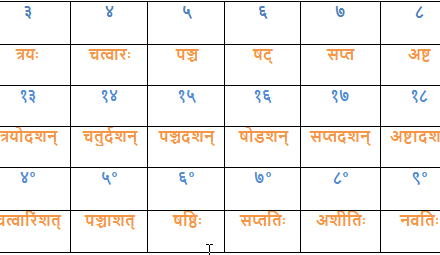The last of the four pronouns of this section is adas, quite naturally you must be unfamiliar with this word as we have not encountered it yet in our course. It is for the first time that we are going to learn about this pronoun. One thing to note about Sanskrit pronoun is that its usage depends on the distance between the speaker and the object. Let us see where do all the pronouns fall in that aspect;
एतद् → इदम् → अदस् → तद्
etad → idam → adas → tad
This (right near us) → this (close at hand) → that (within sight) → that (remote)
Now let us see the endings of adas
adas (masculine)
| अदस् | Singular | Dual | Plural |
|---|---|---|---|
| Case 1 (Subject) | असौ asau | अमू amū | अमी amī |
| Case 2 (object) | अमुम् amum | अमू amū | अमून् amūn |
| Case 3 ("with") | अमुना amunā | अमूभ्याम् amūbhyām | अमीभिः amībhiḥ |
| Case 4 ("for") | अमुष्मै amuṣmai | अमूभ्याम् amūbhyām | अमीभ्यः amībhyaḥ |
| Case 5 ("from") | अमुष्मात् amuṣmāt | अमीभ्यः amībhyaḥ | अमीभ्यः amībhyaḥ |
| Case 6 ("of") | अमुयोः amuyoḥ | अमीषाम् amīṣām | अमीषाम् amīṣām |
| Case 7 ("in") | अमुयोः amuyoḥ | अमीषु amīṣu | अमीषु amīṣu |
adas (feminine)
| अदस् | Singular | Dual | Plural |
|---|---|---|---|
| Case 1 (Subject) | असौ asau | अमू amū | अमूः amūḥ |
| Case 2 (object) | अमुम् amum | अमू amū | अमूः amūḥ |
| Case 3 ("with") | अमुया amuyā | अमूभ्याम् amūbhyām | अमूभिः amūbhiḥ |
| Case 4 ("for") | अमुष्मै amuṣmai | अमूभ्याम् amūbhyām | अमूभ्यः amūbhyaḥ |
| Case 5 ("from") | अमुष्याः amuṣyāḥ | अमीभ्यः amībhyaḥ | अमूभ्यः amūbhyaḥ |
| Case 6 ("of") | अमुष्याः amuṣyāḥ | अमुयोः amuyoḥ | अमूभ्यः amūbhyaḥ |
| Case 7 ("in") | अमुष्याम् amuṣyām | अमुयोः amuyoḥ | अमूषु amūṣu |
adas (neuter)
| अदस् | Singular | Dual | Plural |
|---|---|---|---|
| Case 1 (Subject) | अदः adaḥ | अमू amū | अमूनि amūni |
| Case 2 (object) | अमू amū | अमू amū | अमूनि amūni |
Sandhi
The case 1 masculine plural ami does not have any change
अमी अश्वाः
amī aśvāḥ
Those horses





